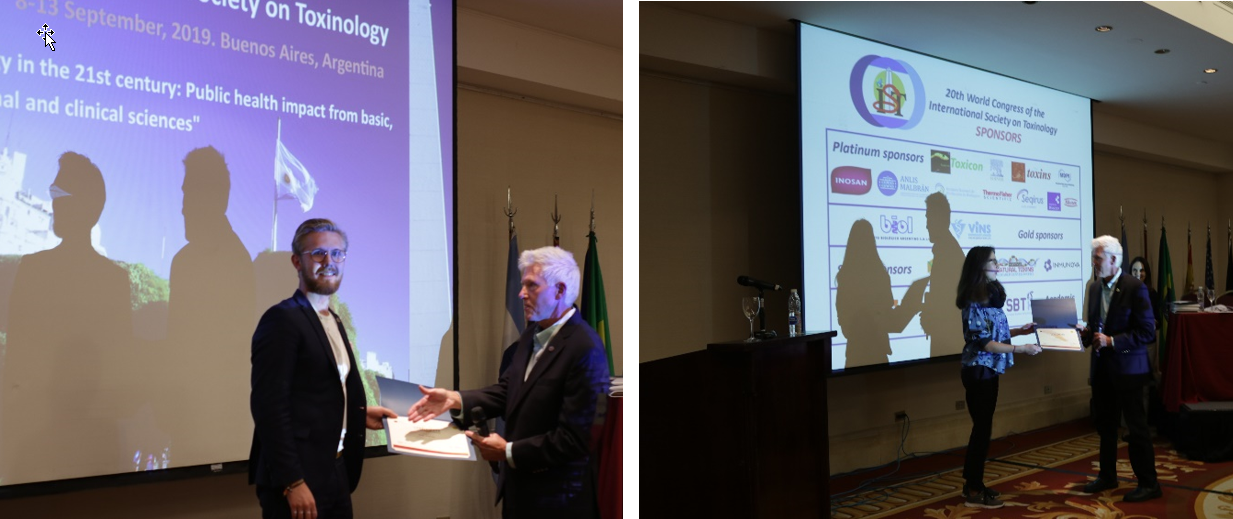
Journal Menu
► ▼ Journal Menu-
- Toxins Home
- Aims & Scope
- Editorial Board
- Reviewer Board
- Topical Advisory Panel
- Instructions for Authors
- Special Issues
- Topics
- Sections & Collections
- Article Processing Charge
- Indexing & Archiving
- Editor’s Choice Articles
- Most Cited & Viewed
- Journal Statistics
- Journal History
- Journal Awards
- Society Collaborations
- Conferences
- Editorial Office
Journal Browser
► ▼ Journal BrowserNeed Help?
Announcements
25 December 2019
Congratulations to the Winners of the Student Poster Award and Student Talk Award at 20th IST World Congress, Buenos Aires, Argentina, 2019 (Sponsored by Toxins)
The editorial team of Toxins would like to congratulate the winner of the Student Poster Award, Jonas Jürgensen, and Student Talk Award, Cebrina Nolan, at the 20th IST World Congress.

Here are the titles and abstracts of their work:
Title: Harnessing Monoclonal Antibodies for Development of a Specific Treatment against Naja nigricollis Envenoming
Author: Jonas Jürgensen
Affiliation: Technical University of Denmark
Abstract:
The African black-necked spitting cobra (Naja nigricollis) is one of the most notorious snake species found on the African continent. Its venom consists of a highly potent mixture of cytotoxins which cause severe local tissue damage in victims, who are left with permanent sequalae after a bite. The availability of antivenom is currently scarce throughout the African continent. Furthermore, due to their heterologous origin and low content of therapeutically active antibodies, these antivenoms have a propensity to cause severe adverse reactions, including serum sickness and anaphylaxis, which could lead to death of the patient.
Recombinant antibodies represent a therapeutic alternative. We are presently developing an antivenom based on recombinant human monoclonal immunoglobulin G (IgG) antibodies, which are predicted to be safer, cost-competitive, and more efficacious than the existing treatment. Here, we present a subset of this work: Through the utilization of phage display technology, the possibility of discovering and expressing novel human single-chain variable antibody fragments (scFv) against the five most medically relevant venom toxins from N. nigricollis has been demonstrated, with four being cytotoxins and one being phospholipase A2. Out of the 486 monoclonal scFvs analyzed, 164 were considered good binders. Of these, 94 were sequenced, resulting in the identification of 31 unique scFvs. The binding properties of these scFvs will be evaluated, and the most promising leads will be converted into an immunoglobulin G format and assessed in vivo. It is our hope that the work in this project will help enable radical improvement in the treatment of snakebite envenoming.
Title: Investigating the Neuromodulatory Effects of Corazonin in Emerald Jewel Wasp Venom
Author: Cebrina Nolan
Affiliation: University of California, Riverside
Abstract:
The parasitoid jewel wasp, Ampulex compressa, induces hypokinesia (a sleep-like state) and reduced fecundity in its host, the American cockroach Periplaneta americana, through direct envenomation of its central nervous system. A proteomic screening of the venom identified over 250 protein components, with many not having been previously observed in arthropod venoms nor found to play a role in modulating insect locomotion. Of the multitude of toxins identified, the presence and function of corazonin was investigated as it was able to bind to Rhodnius prolixus corazonin receptors. Corazonin is a highly conserved peptidergic neurohormone found within all insect orders except Coleoptera (beetles). Despite its conserved sequence, its function varies greatly between different insect genera. A recent study revealing the involvement of corazonin in the behavior switching of ponerine gamergates to infertile workers was associated with the involvement of Ampulex corazonin in suppressing fecundity. These findings led us to investigate the function of corazonin in the venom via injecting Ampulex corazonin into the brains of virgin females. Following treatment, changes in fecundity were monitored by measuring the relative gene expression of vitellogenin yolk proteins, average ovariole protein content, and average ovariole volume size in stung and corazonin-injected females. Changes in cockroach fecundity were compared to nontreated and saline-injected controls. Both the sting and corazonin injections resulted in significant decreases in vitellogenin gene expression as well as a reduction in average ovariole protein content and ovariole size in virgin female cockroaches. Thus, it is suggested that the role of corazonin in venom may be to suppress ovary development and preserve energy within females. Our findings reveal alternative mechanisms of how venoms can inhibit reproductive abilities as well as provide further insight on the effects of corazonin in the central nervous system of arthropods.




